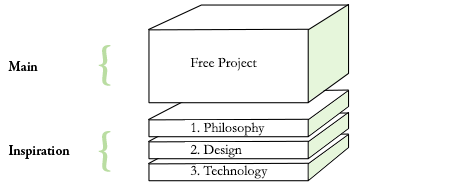
How can Design connect us with Nature?
Natural vs. artificial
In this semester we want to explore the relationship between natural and human-made environments. We are going to design products that reconnect our daily lives with nature.
Designing levels of reality
To a large extent our experience of the world is mediated by technology. In this semester we are particularly interested in latest developments of Mixed Reality, Machine Learning, and 3D printing, where people, animals, plants, and objects seem to shift between their physical presence and various kinds of virtual representations. Things are here and at the same time they are not. We want to understand the impact of these technologies on our understanding of the world, how they can enrich our experience of nature, and how we can avoid their potential pitfalls.
Please note: This project is not a computer course! Even though we receive a quick introduction to current digital technologies in the first four weeks, you can also create a completely non-digital project. At the core of this project is life-friendly design, you can use the medium, format and tools of your choice!
1. Inspirational short project: Virtual Botany
In the first four weeks we are going to create a small botanical exhibition. Each participant will pick a pot plant of their liking to do four little exercises with it.
Exercise 1: Perception

- Draw your plant. (analog)
- Create a virtual 3D model of your plant. (digital)
Exercise 2: Immersion

- Draw a panoramic environment for your plant. (analog)
- Create an immersive environment of your plant in Google Cardboard or Oculus Quest (digital)
Exercise 3: Augmentation

- Draw an invisible aspect (infographic) of your pant. (analog)
- Create an augmented layer for your pant (analog or digital)
Exercise 4: 3D Printing

- Create a physical variation of your augmented layer from exercise 2. (analog)
- Model and refine this variation in virtual 3D to print it out in 3D. (digital)
2. The Toolbox
These four little exercises will be accompanied by a series of short lectures. Thus we acquire a toolbox of skills and knowledge, which will be helpful for the main part of the semester when we work on our free individual projects. We will have three kinds of lectures to form a solid foundation:

Layer 1: Philosophy – Understand the terms and questions
We will start with basic questions about human perception. How do we perceive the world? How do we know what is real and what isn’t? First we have to understand the issues connected with our “natural” perception of the world. Then we can dig into contemporary questions of how the various layers of media have an impact on how we see and understand the world.
Layer 2: Design – Understand various layers of reality
How do you design something which is there but… not really? We want to understand the different layers of reality (Augmented layers of information, immersive environments, etc.) and how we can apply them to our creative projects. In part we can build on existing knowledge from traditional graphic and interaction design. But we will go one step further and take a closer look at the particular design requirements of AR, VR and 3D Printing.
Layer 3: Technology – Learn how to make stuff
We will have quick basic introductions to the following technologies:
- 3D Modelling with Blender
- Augmented Reality with Unity and Spark AR Studio
- Virtual Reality with Unity, Google Cardboard and Oculus Quest
- 3D Printing and Parametric Modelling with Rhino / Grasshopper
3. Free project: Natural Reality
In part 2 of this semester every students works on their personal free project. This will involve the following steps:
Define your interest: What would you like to do?
Set up a productive framework: Which media or tools do you want to use (analog or digital)? What do you want to learn? What format do you want to work in? What ideal outcome do you imagine?
Make a plan: We will learn about a variety of design processes and help each participant to lay out the process fitting the requirements of their personal project.
Work together: Even though every student works on their own project we are going to meet every week for inspiring conversations, critiques, and discussions.
Articulate what you do: Participants will practise to articulate their thoughts and convey their excitement about their topic in a compelling narrative.
Deliver: Every student will successfully complete this semester with a documentation of their short project and their personal free project.